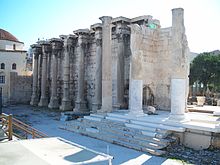Hadrian's Library
The Library of Hadrian was a great library in ancient Athens . It is named after its founder, the Roman Emperor Hadrian .
Hadrian's library consisted of an approx. 100 × 70 m large inner courtyard surrounded by a peristyle of 100 Phrygian marble columns and the actual library building with two reading and lecture rooms each. The entire complex is also called Athens University . The library hall probably had three floors, two of which have survived. On the three floors there would be space for 66 wall cabinets with more than 20,000 scrolls. Today the northern half of the western facade of the peristyle with the Corinthian columns in front of it has been preserved. The ruins of Hadrian's Library are located near the modern Monastiraki Square in Athens' old town ( Plaka ) north of the Acropolis . Right next to Hadrian's Library is the former Tsisdarakis Mosque from 1759, which today houses the ceramics department of the Folklore Museum.
history
Hadrian was an outspoken philhellene and visited Athens several times during his reign (117-138). The art-loving emperor donated several buildings to the city: He had the Roman Agora expanded and completed it as early as the 6th century BC. The temple of Olympian Zeus was started in the 4th century and built the Hadrian's Gate as well as the Hadrian's library in 132. Already 267 the building was the invasion of the Heruli victim. It was later incorporated into the city walls of Athens. The library was not restored until 412 at the behest of the Roman governor. Also in the 5th century an early Christian church was built in the courtyard , which was replaced by a three-aisled basilica in the 7th century . The Megali Panagia Church was built in its place in the 11th century. This was only destroyed in a major fire in 1885. After the church was destroyed, archaeologists began excavation work, which continues to this day.
literature
- Alkistis Choremi-Spetsieri: The Library of Hadrian in Athens. Recent Finds . In: Ostraka 4, 1995, pp. 137-147
- John Travlos : Image dictionary on the topography of ancient Athens. Wasmuth, Tübingen 1971, ISBN 3-8030-1017-9 , pp. 244-252
Individual evidence
Web links
- Brief information and images at stoa.org (English)
- Brief information from the Greek Ministry of Culture (English)
Coordinates: 37 ° 58 ′ 32 " N , 23 ° 43 ′ 34" E
